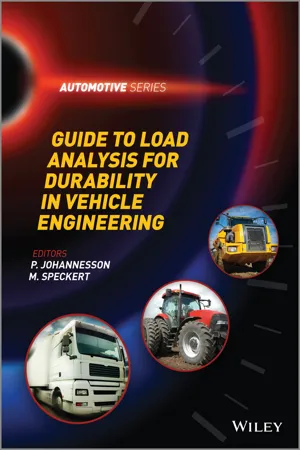
- English
- ePUB (mobile friendly)
- Available on iOS & Android
Guide to Load Analysis for Durability in Vehicle Engineering
About This Book
The overall goal of vehicle design is to make a robust and reliable product that meets the demands of the customers and this book treats the topic of analysing and describing customer loads with respect to durability.
Guide to Load Analysis for Vehicle and Durability Engineering supplies a variety of methods for load analysis and also explains their proper use in view of the vehicle design process. In Part I, Overview, there are two chapters presenting the scope of the book as well as providing an introduction to the subject. Part II, Methods for Load Analysis, describes useful methods and indicates how and when they should be used. Part III, Load Analysis in view of the Vehicle Design Process, offers strategies for the evaluation of customer loads, in particular characterization of customer populations, which leads to the derivation of design loads, and finally to the verification of systems and components.
Key features:
• Is a comprehensive collection of methods for load analysis, vehicle dynamics and statistics
• Combines standard load data analysis methods with statistical aspects on deriving test loads from surveys of customer usage
• Sets the methods used in the framework of system dynamics and response, and derives recommendations for the application of methods in engineering practice
• Presents a reliability design methodology based on statistical evaluation of component strength and customers loads
• Includes case studies and illustrative examples that translate the theory into engineering practice
Developed in cooperation with six European truckmanufacturers (DAF, Daimler, Iveco, MAN, Scania and Volvo) to meet the needs of industry, Guide to Load Analysis for Vehicle and Durability Engineering provides an understanding of the current methods in load analysis and will inspire the incorporation of new techniques in the design and test processes.
Frequently asked questions
Information
Table of contents
- Cover
- Title Page
- Copyright
- About the Editors
- Contributors
- Series Preface
- Preface
- Acknowledgements
- Part One: Overview
- Part Two: Methods for Load Analysis
- Part Three: Load Analysis in View of the Vehicle Design Process
- Appendix A: Fatigue Models and Life Prediction
- Appendix B: Statistics and Probability
- Appendix C: Fourier Analysis
- Appendix D: Finite Element Analysis
- Appendix E: Multibody System Simulation
- Appendix F: Software for Load Analysis
- Bibliography
- Index